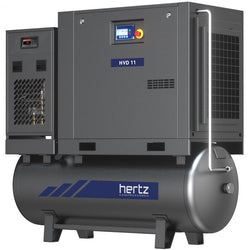Air Compressor Selection
Use this section to provide a description of your blog.
Air compressor selection
Posted by Ed Powell on
When purchasing an air compressor there are several things to consider
How much ACFM (actual cubic feet per minute) "free air" do I need? ACFM is often confused with pressure PSI. Many people think as long as the compressor will build let's say 100 PSI that will be fine. You can build 100 PSI with a bicycle pump but it wont operate air tools or plant equipment. Therefore you need to know the total ACFM for all of your equipment. Lets say you have a body shop and your grinders, files and sanders consume 15 ASCM @ 90 PSIG if they were all operating at once. You would need an air compressor that would produce a minimum of 15 ACFM to operate everything. But lets go one step further. Unless you are willing to purchase a rotary screw air compressor that has a duty cycle of 100%, you would need to oversize a reciprocating compressor by a minimum of 30%. That means you would need a compressor that produces a minimum of 19 ACFM "free air" to operate your equipment and give the air compressor a rest. Many people guess at things, buy a compressor that has an attractive price and when it burns up from over duty cycle( they really don't know what caused it) then they are dismayed. Of course most equipment is not operating all at the same time but its better to over calculate some than to wear out the compressor.Read more
Air compressor selection
Posted by Ed Powell on
When purchasing an air compressor there are several things to consider
How much ACFM (actual cubic feet per minute) "free air" do I need? ACFM is often confused with pressure PSI. Many people think as long as the compressor will build let's say 100 PSI that will be fine. You can build 100 PSI with a bicycle pump but it wont operate air tools or plant equipment. Therefore you need to know the total ACFM for all of your equipment. Lets say you have a body shop and your grinders, files and sanders consume 15 ASCM @ 90 PSIG if they were all operating at once. You would need an air compressor that would produce a minimum of 15 ACFM to operate everything. But lets go one step further. Unless you are willing to purchase a rotary screw air compressor that has a duty cycle of 100%, you would need to oversize a reciprocating compressor by a minimum of 30%. That means you would need a compressor that produces a minimum of 19 ACFM "free air" to operate your equipment and give the air compressor a rest. Many people guess at things, buy a compressor that has an attractive price and when it burns up from over duty cycle( they really don't know what caused it) then they are dismayed. Of course most equipment is not operating all at the same time but its better to over calculate some than to wear out the compressor.Read more
Air compressor overheating 101
Posted by Ed Powell on
Air compressor overheating can come from several factors.
Read more
Air compressor overheating 101
Posted by Ed Powell on
Compressed air water problems 101
Posted by Ed Powell on
Due to the nature of a compressed air system water can become a problem. Many people are unaware that when you compress air you are compressing the moisture in the air and as the air cools you experience condensation.
The first step in solving this problem is to drain your air receiver tank. How often to drain depends on many factors. Most systems need to be drained multiple times daily so you just have to experiment. An automatic drain is an inexpensive way to remove condensate without having to manually drain the receiver multiple times daily.
Draining the receiver is a must and in some cases will eliminate enough moisture for your application. If after draining you still have moisture an air dryer will be the next step
Read more
Compressed air water problems 101
Posted by Ed Powell on
Due to the nature of a compressed air system water can become a problem. Many people are unaware that when you compress air you are compressing the moisture in the air and as the air cools you experience condensation.
The first step in solving this problem is to drain your air receiver tank. How often to drain depends on many factors. Most systems need to be drained multiple times daily so you just have to experiment. An automatic drain is an inexpensive way to remove condensate without having to manually drain the receiver multiple times daily.
Draining the receiver is a must and in some cases will eliminate enough moisture for your application. If after draining you still have moisture an air dryer will be the next step

